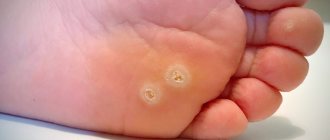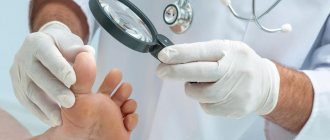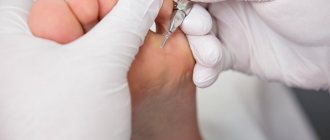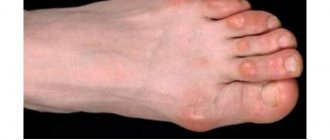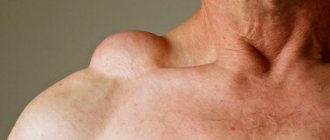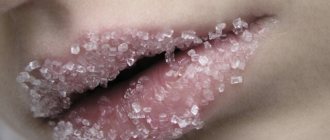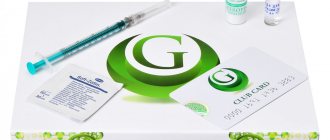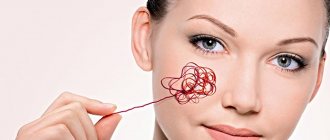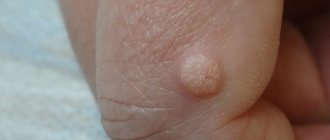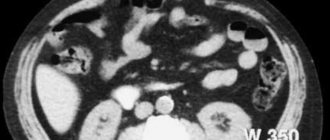Attention!
The presented material is of an informational nature and is aimed at podologists who can take a refresher course on this topic.
CHTA is an educational organization, so treatment consultations are not provided. Our specialists can provide assistance only in matters of obtaining additional professional education - advanced training courses and professional retraining.
Calluses are a problem that every modern person inevitably faces at least once. Uncomfortable shoes, long walks or working on your feet, thin skin – there are many reasons that contribute to the appearance of this unpleasant formation.
How to get rid of dry callus on your finger?
How to quickly get rid of calluses on your feet?
Calluses on feet: how to get rid of them?
How to get rid of callus at home
How to get rid of a callus on the foot?
How to get rid of calluses between your fingers?
In addition to the fact that calluses look unaesthetic, they are also sometimes very painful. Since few people agree to endure discomfort, there are probably a thousand and one ways to get rid of the problem with the help of drugs and products that can be found in any home. The effectiveness of such “grandfathered” methods has not been proven, however, recipes for medicinal mixtures are passed down from generation to generation, which proves their relevance.
How to get rid of dry callus on your finger?
To begin with, it is worth noting the fact that calluses are divided into two types:
- dry;
- wet.
Dry calluses, also known as corns, are most easily removed with a rough pedicure file or regular pumice stone. The best effect is achieved if problem areas are treated dry, without steaming.
For those who still cannot do without first softening the skin, it is recommended to soak their feet in a mixture of soda (2 spoons), liquid soap (2 spoons) and hot water for half an hour. Such a bath will soften the rough epidermis and help remove corns faster than in the case of dry grinding.
Another option is to apply salicylic ointment (10%) to the callus at night. Fans of homemade recipes can prepare a homemade compress from the pulp of black bread, soaked in vinegar or lemon juice, with the addition of grated lemon zest. Regardless of which method you prefer, after lubricating the calluses on your foot, you need to put on a plastic bag and a warm sock. In the morning, all that remains is to cut off the already soft and pliable skin.
If we talk about pharmaceutical products, then a special medicinal patch helps to effectively get rid of corns. It is glued onto pre-steamed feet and changed every 24 hours for 3-4 days (until the callus is completely gone).
Now the question of how to get rid of calluses and corns will no longer arise for you.
Treatment of water callus
Small water calluses heal on their own. But in some cases, aching pain occurs, the liquid takes on an opaque cloudy appearance and the skin around the wound becomes inflamed. This indicates infection of education. It is strictly forbidden to self-medicate; you need to urgently go to the clinic.
If there are no signs of inflammation, then you can speed up the healing process using medications.
The following ointments are suitable for treating wet calluses:
- Levomekol – combines antiseptic and healing properties. The wet callus is sealed with a plaster or covered with a sterile bandage. It is necessary to change at least 3 times a day.
- Salicylic ointment – anesthetizes, relieves inflammation and disinfects. The product is left overnight, and in the morning the leg should be rinsed thoroughly.
- Compeed patch for wet calluses is impregnated with a special composition that disinfects and dries the blister.
Apply the product in a thick layer onto a sterile bandage and apply to the painful area. It is better to apply bandages at night.
For quick healing of formations, it is better to use Compeed patches for wet calluses with hydrocolloid properties. They are made using special technology from breathable fabric. The patches protect the wound from infection, accelerate the skin regeneration process and provide pain relief.
How to quickly get rid of calluses on your feet?
The second type of consequence of wearing tight shoes is water (wet) calluses. The fastest way to get rid of them is with a puncture. This method is controversial, since if the callus is damaged, there is a chance of infection. However, it cannot be denied that calluses freed from fluid heal much better than those that are not punctured.
If you nevertheless decide to “dry” the callus, then take care of sterility in advance: thoroughly wash your hands and the problem area itself, heat the tip of the needle over a fire or disinfect it with alcohol, prepare a napkin/gauze disinfected with an antiseptic to absorb the ichor from the callus.
After the callus is punctured, it must be treated with antimicrobial ointment and sealed with a medicinal plaster. At night, you can additionally apply products that accelerate tissue regeneration.
You can learn more about nutrition rules and the principles of forming a reasonable diet in a
7-module certification course in dietetics and nutrition from leading nutritionist Oleg Iryshkin.
Is it possible to pierce a callus with liquid?
The blood plasma filling the bladder protects the injury site from pain. Therefore, small calluses usually heal on their own and do not need piercing. To do this, simply cover the problem area with a band-aid.
If the formation is large in diameter and causes significant discomfort, it can be pierced. Otherwise, the protruding callus may burst on its own as a result of injury. After a puncture, healing proceeds faster than with an accidental rupture.
To avoid infection and ensure rapid healing, you must follow a number of rules:
- Before piercing, treat damaged skin and hands with an antiseptic solution.
- Use a sterile needle. To disinfect, you can hold it over a fire or put it in alcohol for a few minutes.
- Make punctures on the sides of the callus, holding the needle parallel to the skin.
- If the callus is large, pierce it in several places to completely release the liquid.
- Use gentle movements to get rid of the liquid inside.
- It is better to pierce the first day after the formation of a blister.
- After the puncture, do not remove the covering skin under any circumstances; as it dries, it will come off on its own.
Calluses on feet: how to get rid of them?
Calluses are hard, rough areas of skin with a dot (spot) in the center. They do not have a cavity, but they have a rod that goes deep into the thickness of the epidermis.
Calluses are a consequence of ignoring corns. The problem is most often localized on the heels and balls of the toes. People who wear uncomfortable shoes, suffer from fungal or viral skin infections, and often injure their feet (athletes, ballerinas, etc.) are at risk of developing such an unpleasant defect.
It is possible to remove calluses with a core at home, but doing it yourself is highly not recommended. The fact is that inept manipulations with periodically inflamed calluses are dangerous not only due to the increased likelihood of infection, but also to the risk of injury to the deep layers of the epidermis.
If you find a corn with a dot inside, it is better to immediately consult a dermatologist, who will offer you one of three options for solving the problem:
- Removal of the callus using a special cutter (the depression formed in the skin is filled with an antiseptic).
- Removing calluses with liquid nitrogen.
- Removal of calluses with a carbon dioxide laser (the most modern and effective method of treating calluses, eliminating the risk of inflammation).
All of the above procedures are painless, but in case of increased sensitivity they can be performed using local anesthesia.
Interdigital calluses
Sometimes calluses appear in the spaces between the toes on the feet, less often on the hands.
They cause a feeling of great discomfort.
People around them practically do not see them, but they are very painful.
Interdigital calluses are wet calluses.
The interdigital spaces (thumb and second finger, as well as the ring and little fingers) are favorite places for calluses to localize.
Interdigital calluses are common at any age, for both men and women.
Essentially, callus is an adaptive response of the epidermis to prolonged friction or compression.
In which layers of keratinized epidermis are actively built up at the site of mechanical action.
The causes of calluses between the toes are:
- uncomfortable and tight shoes;
- high heels;
- presence - flat feet;
- finger deformities;
- overweight;
- joint diseases (arthrosis, arthritis or gout);
- swelling of the legs.
How to get rid of callus at home
If for some reason it is not possible to contact a specialist, there are several methods for eliminating callus at home. All techniques are based on the initial softening of the corns and its subsequent mechanical removal.
For the first stage - softening - a patch with salicylic acid is most often used, which is glued to the problem area and then secured with a bandage or any other fixing agent. You need to wear the patch for several days, after which you can try to remove the callus core mechanically. If the “operation” is successful, the remaining indentation in the skin must be treated with iodine and sealed with a band-aid until complete healing.
If the problem was noticed in the early stages, then the removal of the callus will take place quickly and without much discomfort, but if the situation is advanced, then the first attempt to remove the rod may end unsuccessfully: the “cap” of the callus will be removed, but subsequent manipulations will be very painful.
Even taking into account the possibility of getting rid of callus on your own at home, in order to avoid complications, it is better to contact a qualified dermatologist.
What to do with hard calluses?
A hard callus is essentially a dry callus.
Naturally, you need to get rid of it.
Let's take a closer look at some official pharmaceutical products for the treatment of calluses.
Treated with Anticorn Super cream.
It is used to moisturize and gradually soften.
It contains many natural plant components with bactericidal and softening properties.
They are also treated with the oily liquid “Feresol” with a cauterizing effect due to the content of phenol and tricresol.
It also has antimicrobial, anti-inflammatory, bactericidal and softening effects.
They are also treated with a very effective remedy - Roacutane gel.
This gel has a keratolytic effect.
Due to the content of salicylic, lactic, boric, benzoic and citric acids in its composition.
And finally, a few words about the Salipoda patch.
This convenient patch has long proven its effectiveness.
It has a pronounced softening antimicrobial effect.
But before using these products, you must carefully re-read all contraindications and strictly adhere to them.
How to get rid of a callus on the foot?
Corns on the feet are a common problem, the solution of which is made difficult by the constant load on this place while walking. If you do not take into account specialized creams, oils, ointments and plasters sold in any pharmacy, you can get rid of calluses on the feet using folk recipes.
For example, steaming the skin in a bath of hot water diluted with a strong chamomile decoction helps to cope with corns. It takes half an hour to soften the rough skin of the feet, after which the problem area should be thoroughly treated with pumice, wiped dry and lubricated with nourishing cream or fatty oil (olive, almond, sandalwood). To enhance the effect, you need to put on socks and take a horizontal position for a while so that the skin is moisturized and softened as much as possible.
It is important to remember that neither folk remedies nor pharmaceutical remedies for calluses will help if you continue to wear uncomfortable, tight shoes. Filed-off corns will simply return in a more severe form.
Prevention of water blisters
There are several recommendations that will help prevent the appearance of vesicular calluses. To prevent a wet callus from forming on the skin, do the following:
- Pick up new shoes after lunch;
- Use silicone pads to prevent the hard fabric of your shoes from chafing;
- Wear socks only made from natural fabric;
- Shoes must be dried after walking and playing sports, especially in the summer;
- Use special anti-sweating products;
- Several times a week, perform foot baths with natural ingredients: chamomile, calendula, oak bark.
- Massage your feet regularly with a moisturizing cream or oil that can soften the skin of your feet.
To prevent the formation of wet calluses on your hands, you should wear special protective gloves when working in the garden, doing repairs and playing sports.
How to get rid of calluses between your fingers?
To understand how to get rid of calluses on your feet, including between your toes, you need to know what causes the problem.
Diseases such as:
- rheumatoid arthritis, arthrosis;
- obesity;
- permanent swelling of the limbs;
- flat feet;
- gout;
- bursitis;
- arteritis.
Vitamin A deficiency can also play a decisive role, so if you have persistent problems with the skin of your legs, you should first pay attention to your health status.
You can soften the epidermis by adding the following ingredients to hot water intended for baths:
- salt/soda/vinegar;
- soap/shower gel/bath foam;
- decoction of oak bark/chamomile.
After cutting down the callus, traditional healers suggest making compresses from:
- tomato;
- lemon;
- crushed boiled potatoes;
- onion/garlic juice;
- prunes boiled in milk.
How doctors remove calluses
The fastest, safest and most painless method is hardware procedures. Removal of the formation is carried out using a special cosmetology device equipped with an automatic cutter fixation system. This eliminates the risk of soft tissue damage. The procedure itself is painless and does not require special preparation. The session time ranges from 10 to 60 minutes. It depends on the number of dry calluses and the degree of their neglect.
Before starting work and during the procedure, the skin is thoroughly disinfected. In case of increased sensitivity, the patient is given topical anesthesia. When treating calluses and corns, the skin is cooled using a spray.
After removing a callus or corns, the skin is polished, and the edges of the treated area are smoothed so that there is no discomfort when walking later. After completion of the procedure, the treated surface is protected with a bandage.
In this way, you can remove any corns, including dry calluses on the foot.
Features of hardware procedures:
- absolute safety – the surface being treated is thoroughly disinfected, which eliminates the risk of infection;
- speed – unlike home procedures, the removal of corns and calluses in a cosmetology clinic is performed quickly and efficiently. One procedure is enough;
- painlessness – automatic fixation of the cutter on the equipment protects the skin from accidental injury and pain;
- no contraindications – anyone can use hardware callus removal.
Complications of calluses
Failure to pay attention to calluses can lead to dangerous and unpleasant consequences.
Especially wet, rod and water ones.
But the presence of rod formations causes severe pain and discomfort, and the presence of wet and rod formations often leads to infection.
Which threatens with an abscess, abscess, and in advanced cases even gangrene.
Corns lead to cracks on the plantar surface of the feet.
At the same time, walking is very painful.
Secondary infection - bacteria and fungi - easily penetrates through these cracks.
The appearance of calluses is often caused by a viral infection.
You definitely need to get rid of it; just removing the calluses will not be enough.
General treatment with antiviral drugs is mandatory.
You need to remember that calluses are not such a harmless thing, and take them seriously.
Suppuration of calluses
If calluses are treated untimely and incorrectly, they can become inflamed and fester.
In fact, the appearance of purulent exudate also indicates that the immune system is working fully and is trying to cope with various infections that appear in the outbreak .
Pus threatens to enter the bloodstream, which can result in sepsis, blockage of blood vessels or embolism.
Chamomile baths and hydrogen peroxide are the first means to treat festering calluses, after which you need to consult a doctor or a medical facility.
To prevent the infection from spreading, it is necessary to treat the callus with gel or ointment with an antiseptic.
Then secure this product with a sterile bandage.
Treatment is carried out by applying the drug to the area of the leg affected by the pathological process.
Then it is all covered with a sterile bandage.
And this procedure should be done at least twice during the day, and preferably three.
Purulent forms must be washed with solutions of potassium permanganate, furatsilin or three percent hydrogen peroxide.
With advanced purulent calluses, seeking help from qualified specialists is simply a must.
To remove pus from a callus, it must be drained.
Based on individual characteristics and the degree of complexity of the purulent process, the specialist prescribes therapeutic measures.
